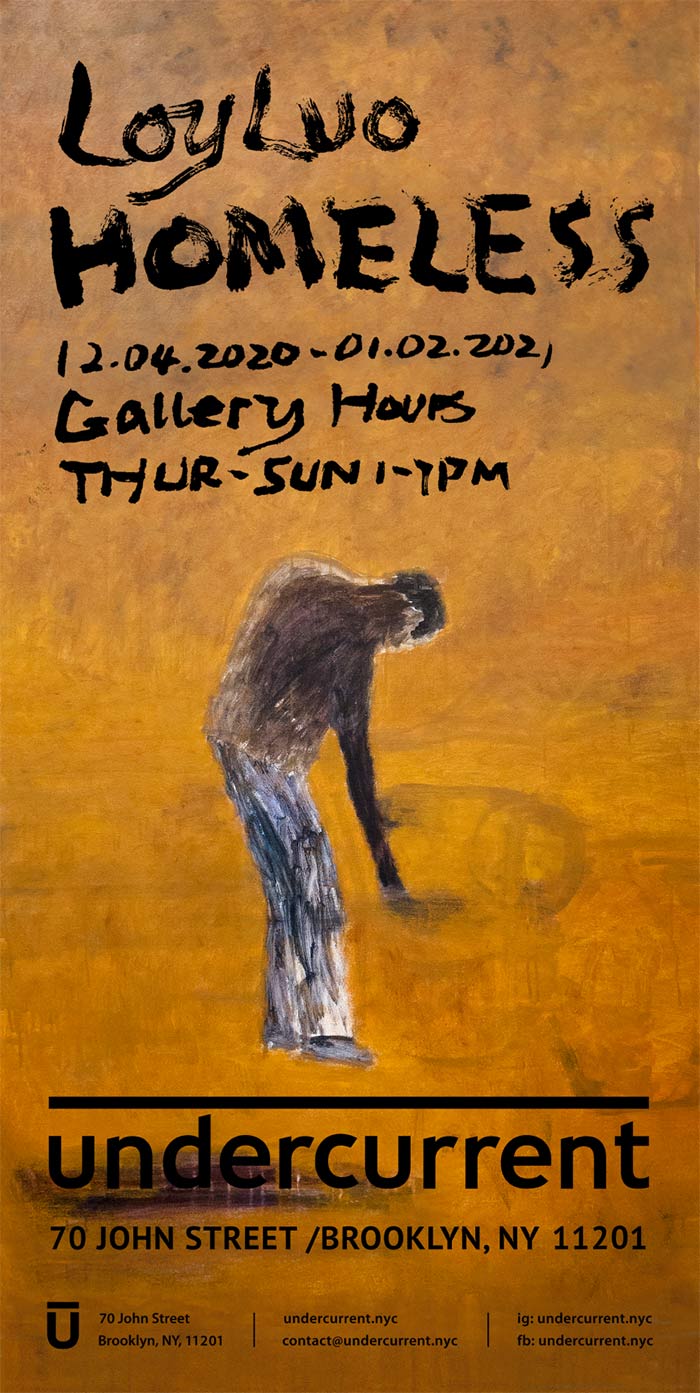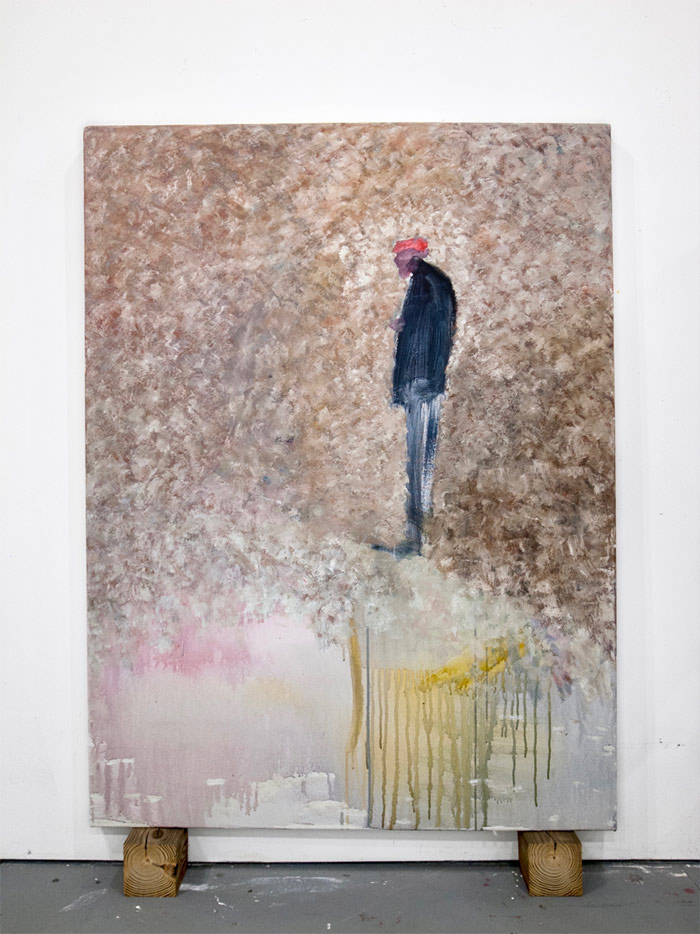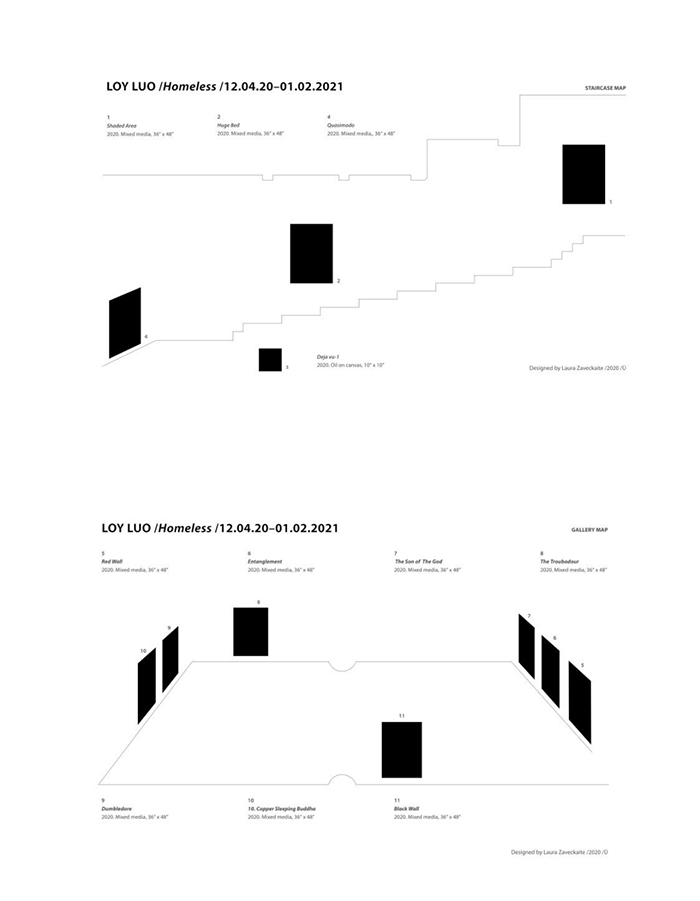
主办单位:纽约暗流画廊
开幕时间:2020年12月4日17:00-21:00
展览日期:2020年12月4日-2021年1月2日周四-周日13:00-19:00
展览地址:70 John st. Brooklyn, NYC
Sponsor: Undercurrent Gallery, New York
OpeningReception:5-9 PM, December 4th, 2020
ExhibitionDate: December 4th, 2020 -- January 2nd, 2021
Thursday -- Sunday,1 --7PM
ExhibitionAddress: 70 John St. Brooklyn, NYC
展览前言
一个生命在我们居住的建筑几何图形上留下印记,要多久,要到什么程度,才能给我们留下温暖的躯体的印象?在暗流画廊举办的羅一个展《无家可归》的十幅作品中,艺术家描绘了一幅揭示等级结构内部和之间不确定存在的褪色的风景。羅一用一种不安的、近乎强迫性的绘画手法所创作的作品,其媒介似乎在画板上模压成型,它们记录着我们在生命边缘化过程中的共谋。在画作近乎崩解的视觉高潮中,身体和场所的边界模糊让我们见证了人体的消解。在《纠缠》和《游吟诗人》这些作品中,我们看到所有的支撑性基础设施都消失了,只留下一个不断变化并正消融的人影,而个体的匿名性也反映了环境的正式崩溃。羅一的作品如同堆叠在僵硬的块面上,因此显然并非是对一个场景的审美描绘,相反,它们与美术馆的脚手架有着内在联系,从而力邀我们参与到这些孤立故事之中或周围。在这些沉甸甸的城市景观中,羅一将被忽视的人物形象浮现出来,并将其植入我们不得不面对的现实中。
关于纽约这座城市,可以有很多说法,但最适用于此的是对其建筑及其内部生活的不断重组的忠诚:正如德塞托所描述的,一种持续的,被认为不合适的东西迅速被抛弃的垂直性。随着这座城市所进行的无情的变革,它的居民在脆弱的微散居住状态中疲于生存。那些居住在公共空间和私人空间裂隙中的人,表现出了一种不确定性,往好了说,这种不确定性是对“共同选择”的挑战,往坏了说,是政治失败的证明。羅一对人类存在的形而上学的关注,以及她对媒介的安静而敏捷的处理,让她的观众感到刺痛不安。人与基础设施之间的边界变得不可分割,无面且孤独的身影隐退于城市网格中。我们在城市的日常活动中遭遇这些孤独的身影,并认识到我们与他们的脱离。当这位艺术家把无面者的历史集中在没有人情味的城市风景中时,我们不得不做出选择:我们是要介入这些人物不可避免的解体,让他们消解在自己的背景中,还是只是远远旁观?羅一笔下那些常常处于停滞状态的人物,站在有条件的人类行为的需求与奖赏之外,促使我们质疑自己对这个体系的加入。
阿德里亚娜·弗隆
The preface
How long, and to what degree, must a being imprint itself upon the geometries of our lived architecture before imparting suggestions of a warm body? In the ten paintings that comprise Homeless, Loy Luo's solo exhibition with Undercurrent, the artist portrays a faded landscape that reveals an indeterminate existence within and between hegemonic structures. With an unquiet, almost compulsive painterly hand, Luo creates paintings whose medium seems to molder onto the panels, recording our complicity in the peripheralization of living beings. Disintegration comes to its visual crescendo where the delineation between body and locale seems to muddy and blur, having us witness the dissolution of human bodies. In pieces such as Entanglement, and The Troubadour, we see all supportive infrastructure fall away, leaving the figure in a constant flux of disintegration, the anonymity of the individual reflecting the formal breakdown of the environment. Stacked upon wooden blocks, Luo’s paintings refute their status as mere aesthetic depiction of a scene, instead becoming intrinsically linked with the gallery’s scaffolding and thus insisting upon our participation both within and around these stories of isolation. In these heavy cityscapes, Luo tenderly surfaces figures who have been overlooked and inserts them in corporeality we cannot help but face.
Many things can be said about the city of New York but the most applicable here would be an allegiance to the unceasing restructuring of its buildings and the lives within them: as De Certeau describes it, a constant verticality in which those deemed unfit are swiftly discarded. As the city performs relentless alterations, its inhabitants strain to survive inside fragile micro-diasporas. Those who inhabit the chasm between public and private space embody an indeterminacy that, at best, defies co-option and, at worst, is testament to political failure. Luo’s metaphysical preoccupations with human existence and her quiet, agile handling of the medium elicit a needling dis-ease in her viewer. Faceless and solitary, the boundaries between person and infrastructure becomes indissoluble, causing the figure to recede into the grid of the city. We know these solitary figures from our daily movements around the city and recognize our disengagement from them. As the artist centralizes faceless histories in her impersonal cityscapes; we grapple with a choice: do we intervene in the inevitable disintegration of these figures into their encroaching backgrounds or simply watch from afar? Luo's figures, often in stasis, stand outside of both the demands and rewards of conditioned human behavior, pushing us to question our accession to this system.
Adriana Furlong

图:游吟诗人 综合材料 36×48cm 2020
IMAGE:Troubadour Mixed Media,36×48cm,2020
艺术家陈述
纽约无家可归者的形象令人震惊。在这个人类引以为豪的文明世界里,底层生活场景极大激发了我的创作热情。我经常看到很多有精神问题的无家可归者手舞足蹈,大声吟咏,骄傲地象行走于天街。他们让我想起古代游吟诗人,所以每当我看到他们,总是心怀敬畏。我一直认为艺术家也是天生的流浪者,他们也有各种心理问题,因为他们对自己所处时代的问题比普通人更敏感。
2020年一月我来纽约,突如其来的疫情带给像我这样的旅行者前所未有的无家可归的体验。一开始,从中国传来疫情爆发的消息,亲友们出于关心建议我不要回国。两个月后,纽约成为疫情中心,亲友们因为大多数人的安全考虑希望我不要回家。后来更有各种断航、天价票、隔离检测标准设置等种种措施极尽所能地阻挡着人们的回归路。疫情对亲情、人情的尖利挑战以及所引起的纠结创痛早已令人失语地超出了过往思想者们对人性思考的所有深度。
作品的“无脸”特征既吻合大时代下身份缺失带来的迷惑感受,也双关着失去尊严的隐喻。而这一灵感最初来自疫情原始恐慌中的所见:当大多数人都已使用面具来保护自己免受病毒感染时,无家可归者一如既往的透明的脸上却依然不戴面具。我突然想到,利用面具掩示真实自我的人常在社会中获得成功,而袒露真实自我的人却常成为失败者,这不得不令人对社会运作体系中的身份系统产生怀疑。而当目睹“卡西莫多(Quasimodo)”驼背的身体散发出雕塑般的庄严,“游吟诗人(Troubadour)”孤立于历史废墟上的身影令人唏嘘时,这些世俗社会定义的无用者的存在让我关联到提倡无用之用的中国古典哲学。
事实上,除了一些人被迫流离失所,不得不睡在公共空间,帐篷、睡袋、甚至硬纸盒里,疫情更让无数人都收获了类似无家可归的经历:我们很没有面子地在外面吃饭,坐街边台阶上休息,没有厕所可用,而且总是可耻地孤独……
羅一
Artist Statement
The images of New York's homeless shocked me. In this so-called civilized world that human beings are proud of, the scenes of underclass life both greatly appalled me and also inspired my passion for creation. I often see homeless people with mental health problems dancing, chanting loudly and walking proudly down the street. They remind me of ancient minstrels, so whenever I see them, I am always in awe. I have always believed that artists are also born homeless, and they also have various psychological problems, because they are more sensitive to the problems of their own times than ordinary people.
When I arrived in New York in January 2020, a sudden outbreak brought travelers like me an unprecedented feeling of homelessness. At first, when news of the outbreak came from China, relatives and friends advised me not to return home out of concern. Two months later, when New Yorkbecame the center of the epidemic, my friends and family wanted me not to go home out of concern for the safety of others at home. Later, there were a variety of obstacles such as canceled flights, sky-high ticket prices, quarantine testing standards, etc., to prevent people from returning. The acute challenge of the epidemic to family relationships and relations to others, and the unusual entanglements and wounds it has caused, is beyond the depth of previous thinkers' thinking about human nature.
The"faceless" feature of these paintings should be consistent with the confused feeling brought about by the loss of identity during this unique time, and is also a pun on the human notion of dignity. The inspiration for these works originally came from my observations in the original panic of the epidemic: while most people had used masks to protect themselves from the virus, the homeless didn't wear masks over their faces. It occurred to me that those who mask their true selves often succeed in society, while those who reveal their true selves often fail, which raises doubts about the identity in the social system. And when I saw the hunchback body of”Quasimodo” standing, sculptural and solemn, or the lonely figure of“Troubadour" on the historical ruins, I saw the connection between the useless presence defined by the secular social order and the useless as articulated by Chinese classical philosophy on the inherent value of the useless.
In fact, aside from the fact that some people have been displaced and have to sleep in public Spaces, in tents, sleeping bags and even cardboard boxes, the epidemic has also brought the experience of homelessness to countless others: we eat out, rest on street steps, have no toilets to use, and are often always shamefully alone......
Loy Luo
附:画廊观展地图
Attached:Gallery Map

内容来源:www.undercurrent.nyc和www.loyluo.art
鸣谢:
国际女性艺术家协会
International Association of Female Artists
CRS记忆与分享中心
CRS Center for Remembering & Sharing
因赛艺术
Insight Art
苇草智酷
Cool Reeds
路途传媒
LuTu Advertising Media
格里森健身房
Gleason’s Gym
四块科技
SQUARE TECH




